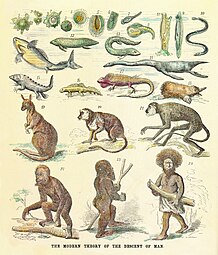Missing link (human evolution)

"Missing link" is a hypothetical or recently-discovered
The term "missing link" has been supported by geneticists since evolutionary trees only have data at the tips and nodes of their branches; the rest is inference and not evidence of fossils.[citation needed] However, it has fallen out of favor with anthropologists because it implies the evolutionary process is a linear phenomenon and that forms originate consecutively in a chain. Instead, last common ancestor is preferred since this does not have the connotation of linear evolution, as evolution is a branching process.[1]
There is no singular missing link. The scarcity of transitional fossils can be attributed to the incompleteness of the
Historical origins
The term "missing link" was influenced by the 18th-century
The earliest publication that explicitly uses the term “missing link” was in 1844 in
Historical beliefs about the missing link

Jean-Baptiste Lamarck envisioned that life is generated in the form of the simplest creatures constantly, and then strive towards complexity and perfection (i.e. humans) through a series of lower forms. In his view, lower animals were simply newcomers on the evolutionary scene. After Darwin's On the Origin of Species, the idea of "lower animals" representing earlier stages in evolution lingered, as demonstrated in Ernst Haeckel's figure of the human pedigree. While the vertebrates were then seen as forming a sort of evolutionary sequence, the various classes were distinct, the undiscovered intermediate forms being called "missing links".
Haeckel claimed that human evolution occurred in 24 stages and that the 23rd stage was a theoretical missing link he named Pithecanthropus alalus ("ape-man lacking speech").
The search for a fossil that connected man and ape was unproductive until the Dutch paleontologist Eugene Dubois went to Indonesia. Between 1886 and 1895 Dubois discovered remains that he later described as "an intermediate species between humans and monkeys". He named the hominin Pithecanthropus erectus (erect ape-man), which has now been reclassified as Homo erectus. In the media, the Java Man was hailed as the missing link. For instance, the headline of the Philadelphia Inquirer on February 3, 1895, was "The Missing Link: A Dutch Surgeon in Java Unearths the Needed Specimen".[11]
Famous "missing links" in human evolution

Among the famous fossil finds credited as the "missing link" in human evolution are:
- Neanderthal (Homo neanderthalensis): A sibling human species.
- Java Man (Homo erectus): Discovered by Eugene Dubois in 1891 in Indonesia. Originally named Pithecanthropus erectus.
- Piltdown Man: A set of bones found in 1912 thought to be the "missing link" between ape and man. Eventually revealed to be a hoax.
- Nebraska Man: Originally described as an ape by Henry Fairfield Osborn in 1922, on the basis of a tooth found by rancher and geologist Harold Cook in Nebraska in 1917. Later, the original classification proved to be a mistake, and was retracted in 1927. It was never widely accepted.
- Taung Child (Australopithecus africanus): Discovered by Raymond Dart in 1924 in South Africa.
- Heidelberg Man: Probably ancestral to Homo sapiens & Homo neanderthalensis.
- Homo habilis (described in 1964) has features intermediate between Australopithecus and Homo erectus, and its classification in Homo rather than Australopithecus has been questioned.[12]
- Lucy (Australopithecus afarensis): Discovered in 1974 by Donald Johanson in Ethiopia
- Australopithecus sediba: A series of skeletons discovered in South Africa between 2008 and 2010
References
- ^ "missing link | evolutionary theory | Britannica". www.britannica.com. Retrieved 2021-11-30.
- ^ ISBN 978-0-19-927685-1.
- OCLC 432702791.
- S2CID 83708471.
- ^ Snyder, S. "The Great Chain of Being". Archived from the original on 2017-07-28.
- ^ Chambers, Robert; Ireland, Alexander (1884). Vestiges of the Natural History of Creation. W. & R. Chambers.
- ^ Lyell, Sir Charles (1851). A Manual of Elementary Geology: Or, The Ancient Changes of the Earth and Its Inhabitants, as Illustrated by Geological Monuments. Murray.
- ^ Lyell, Sir Charles (1863). The Geological Evidence of the Antiquity of Man. John Murray.
Geological Evidences of the Antiquity of Man.
- ^ Haeckel, Ernst (1874). The Evolution of Man.
- PMID 19805251.
- ^ "The Missing Link: A Dutch Surgeon in Java Unearths the Needed Specimen" (PDF). Philadelphia Inquirer. February 3, 1895.
- PMID 10999270. p. 41: "A recent reassessment of cladistic and functional evidence concluded that there are few, if any, grounds for retaining H. habilis in Homo, and recommended that the material be transferred (or, for some, returned) to Australopithecus (Wood & Collard, 1999)."
